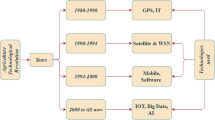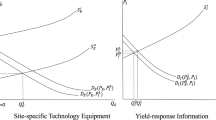Abstract
As precision agriculture strives to improve the management of agricultural industries, the importance of scientific validation must not be forgotten. Eventually, the improvement that is imparted by precision agriculture management must be considered in terms of profitability and environmental impact (both short and long term). As one form of precision agriculture, we consider site-specific crop management to be defined as: “Matching resource application and agronomic practices with soil and crop requirements as they vary in space and time within a field.” While the technological tools associated with precision agriculture may be most obvious, the fundamental concept will stand or fall on the basis of scientific experimentation and assessment. Crucial then to scientifically validating the concept of site-specific crop management is the proposal and testing of the null hypothesis of precision agriculture, i.e. “Given the large temporal variation evident in crop yield relative to the scale of a single field, then the optimal risk aversion strategy is uniform management.” The spatial and temporal variability of important crop and soil parameters is considered and their quantification for a crop field is shown to be important to subsequent experimentation and agronomic management. The philosophy of precision agriculture is explored and experimental designs for Precision agriculture are presented that can be employed in attempts to refute the proposed null hypothesis.
Similar content being viewed by others
References
R. J. Barnes, Bounding the required sample size for geologic site characterisation. Mathematical Geology 20, 477–490(1988).
R.A. Fisher, Statistical Methods and Scientific Inference, (Oliver and Boyd, Edinburgh, UK, 1959), 175pp.
R.A. Fisher, (1970) Statistical Methods for Research Workers, 14th ed. Edinburgh, UK: Oliver and Boyd, 362pp.
R.A. Fisher and F. Yates, Statistical Tables for Biological, Agricultural and Medical Research, 6th ed. (Hafner Publishing Company, New York, USA, 1963), 146pp.
S.N. Goodman, p-values, hypothesis tests, and likelihood: implications for epidemiology of a neglected historical debate, American Journal of Epidemiology 137, 485–496(1993).
R.G. Kachanoski and G. L. Fairchild, Field scale fertiliser recommendations: the spatial scaling problem, Canadian Journal of Soil Science 76, 1–6(1996).
R.M. Lark and J. V. Stafford, Classification as a first step in the interpretation of temporal and spatial variation of crop yield, Annals of Applied Biology 130, 111–121(1997).
A.B. McBratney and M. J. Pringle, Spatial variability in soil-implications for precision agriculture. In: Precision Agriculture '97: Proceedings of the 1st European Conference on Precision Agriculture, edited by J. V. Stafford (BIOS, Oxford, UK, 1997), pp. 3–32.
A.B. McBratney and B. M. Whelan, The Potential for Site-Specific Management of Cotton Farming Systems (CRC for Sustainable Cotton Production, Narrabri, Australia, 1995), 46pp.
P.B. Medawar, Advice to a Young Scientist (Harper & Row, New York, USA, 1979), 109pp.
K.R. Popper, Conjectures and Refutations: The Growth of Scientific Knowledge (Routledge, London, 1963), 431 pp.
M.J. Pringle, A. B. McBratney, and S. E. Cook, Some methods of estimating yield response to a spatially variable input. In: Precision Agriculture '99: Proceedings of the 2nd European Conference on Precision Agriculture, edited by J. V. Stafford (Sheffield Academic Press, Sheffield, UK, 1999), pp. 309–318.
B.M. Whelan, Reconciling Continuous Soil Variation and Crop Yield-a study of some implications of within-field variability for site-specific crop management. Unpublished Ph.D. thesis, (University of Sydney, Australia, 1998).
B.M. Whelan, A. B. McBratney, and R. A. Viscarra Rossel,Spatial prediction for precision agriculture. In: Precision Agriculture: Proceedings of the 3rd International Conference on Precision Agriculture, edited by P. C. Robert, R. H. Rust, and W. E. Larson (ASA-CSSA-SSSA, Madison, WI, 1996), pp. 331–342.
Author information
Authors and Affiliations
Rights and permissions
About this article
Cite this article
Whelan, B.M., McBratney, A.B. The “Null Hypothesis” of Precision Agriculture Management. Precision Agriculture 2, 265–279 (2000). https://doi.org/10.1023/A:1011838806489
Issue Date:
DOI: https://doi.org/10.1023/A:1011838806489




